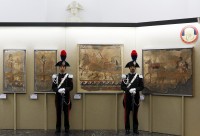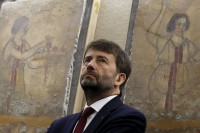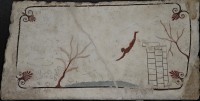 A group of five frescoes torn from the walls of a tomb in Paestum, southern Italy, have been found by the Carabinieri art theft squad. The frescoes date to around the 4th century B.C. and depict a warrior returning triumphant from battle on his horse followed by attendants, one of them driving a mule laden with spoils, and being greeted by the lady of the household and two of her servants. They originally adorned the tomb of a wealthy man of the indigenous southern Italian tribe of the Lucanians before looters got to them. Unfortunately, since the frescoes were brutally removed and smuggled into the netherworld of the antiquities trade, we don’t know which tomb they came from or anything about its contents that might give us more information about the tomb’s owner.
A group of five frescoes torn from the walls of a tomb in Paestum, southern Italy, have been found by the Carabinieri art theft squad. The frescoes date to around the 4th century B.C. and depict a warrior returning triumphant from battle on his horse followed by attendants, one of them driving a mule laden with spoils, and being greeted by the lady of the household and two of her servants. They originally adorned the tomb of a wealthy man of the indigenous southern Italian tribe of the Lucanians before looters got to them. Unfortunately, since the frescoes were brutally removed and smuggled into the netherworld of the antiquities trade, we don’t know which tomb they came from or anything about its contents that might give us more information about the tomb’s owner.
The slabs were discovered last May, 20 years after the seminal investigation that first alerted the art squad to their theft. Operation Geryon was launched by the Carabinieri in 1995 after the theft of eight Greek vases from a Castle of Melfi in south central Italy. A fatal accident ultimately broke the case, when dealer Pasquale Camera crashed his car and died. Highway police found Polaroids of what appeared to be freshly looted artifacts in Camera’s car. A subsequent search of his house which turned up hundreds more pictures and a paper trail a mile long which named names, leading to 70 more raids and the arrest of close to 20 people involved in the looted antiquities trade.
 The frescoes were found locked in a bank in Campione d’Italia, a town in Lombardy just a few miles form the Swiss border, which is a shocking twist to the oft-told tale because usually the ill-gotten goods cross the border into Switzerland as soon as possible. The collector who was in illegal possession of them claimed he had no idea they were stolen. We’re to believe he saw five Lucanian fresco panels, each of them cracked and damaged in the same way across the middle, and didn’t realize those were the characteristic wounds left by smugglers when they broken the frescoes in half for easier illegal export.
The frescoes were found locked in a bank in Campione d’Italia, a town in Lombardy just a few miles form the Swiss border, which is a shocking twist to the oft-told tale because usually the ill-gotten goods cross the border into Switzerland as soon as possible. The collector who was in illegal possession of them claimed he had no idea they were stolen. We’re to believe he saw five Lucanian fresco panels, each of them cracked and damaged in the same way across the middle, and didn’t realize those were the characteristic wounds left by smugglers when they broken the frescoes in half for easier illegal export.
The recovered paintings will be on display at the Historic Museum of the Carabinieri in Rome before moving to their permanent home at the Paestum Archaeological Museum on January 10th.
Paestum was a Greek colony founded around 600 B.C. 65 miles south of Naples on the southwestern coast of Italy. They called it Poseidonia after Poseidon, god of the sea. The Lucanians conquered the city in the late 5th century B.C. and renamed it Paistos. The name was Latinized to Paestum when the Romans took control in 273 B.C. after their final defeat of King Pyrrhus of Epirus whom the Lucanians had sided with against Rome.
The Lucanians left behind hundreds of richly decorated tombs in necropoli around Paestum. They are and have long been a prime target for tombaroli, the Italian term for the grave robbers who, through chains of increasingly well-connected and well-paid dealers, supply the international antiquities market with archaeological treasures that auction houses and museums can pretend come from “a Swiss private collection.”
 Browse this Flickr album for a marvelous collection of photographs of Lucanian tomb frescoes from the Paestum Archaeological Museum. The ones with men reclining at a symposium and the last picture of the diver are from the Tomb of Diver and are Greek, not Lucanian. The painting of the diver is unique in its iconography and is the most famous artifact in the museum, so much so that the silhouette of the man diving is the museum’s logo. Wikimedia has a great many pictures of Lucanian tomb frescoes from the museum as well.
Browse this Flickr album for a marvelous collection of photographs of Lucanian tomb frescoes from the Paestum Archaeological Museum. The ones with men reclining at a symposium and the last picture of the diver are from the Tomb of Diver and are Greek, not Lucanian. The painting of the diver is unique in its iconography and is the most famous artifact in the museum, so much so that the silhouette of the man diving is the museum’s logo. Wikimedia has a great many pictures of Lucanian tomb frescoes from the museum as well.